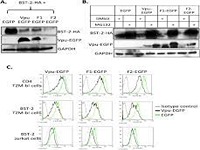Viruses belonging to the M group of human immunodeficiency virus (HIV-1) are the most virulent among the four HIV-1 groups. One factor that distinguishes the M group HIV-1 from others is Vpu, a membrane localized accessory protein, which promotes the release of virions by neutralizing the antiviral host cell protein BST-2. To investigate if this activity is determined by the topology of Vpu or by conserved amino acid residues, we prepared chimeric forms of Vpu by replacing its transmembrane domain with those from its topological homologs. Although the chimeric Vpu proteins downregulated BST-2, these substantially reduced virus production as well. Molecular modeling studies on Vpu from different HIV-1 groups and the chimeric Vpu proteins showed that shape and the availability of a hydrophobic interface are more important for BST-2 antagonism than conservation of the amino acid sequence. Our data suggest that the HIV-1 Vpu-M protein has evolved topologically to interact with BST-2, and that the Vpu/BST-2 interface can be exploited as a target to limit HIV-1 replication.

N Khan, S Padhi, P Patel, UD Priyakumar, S Jameel,

